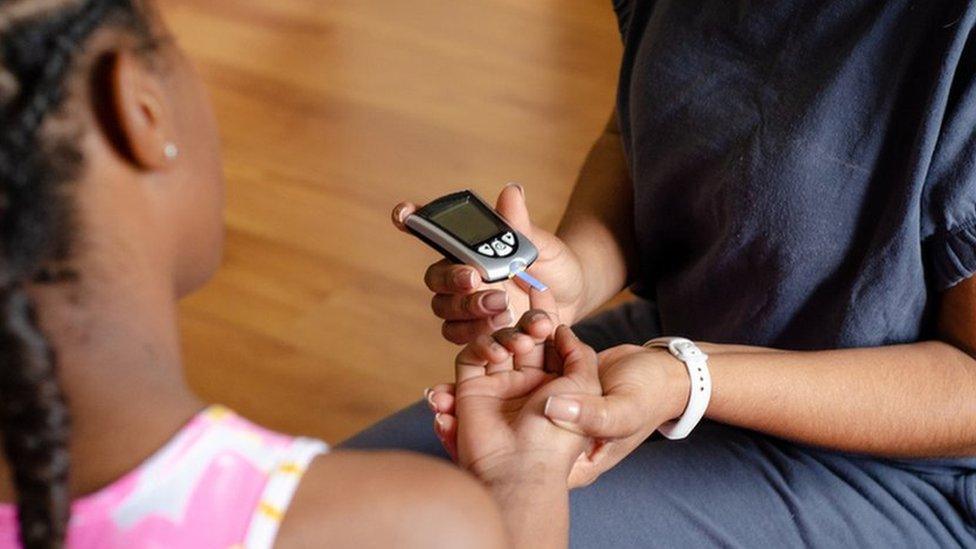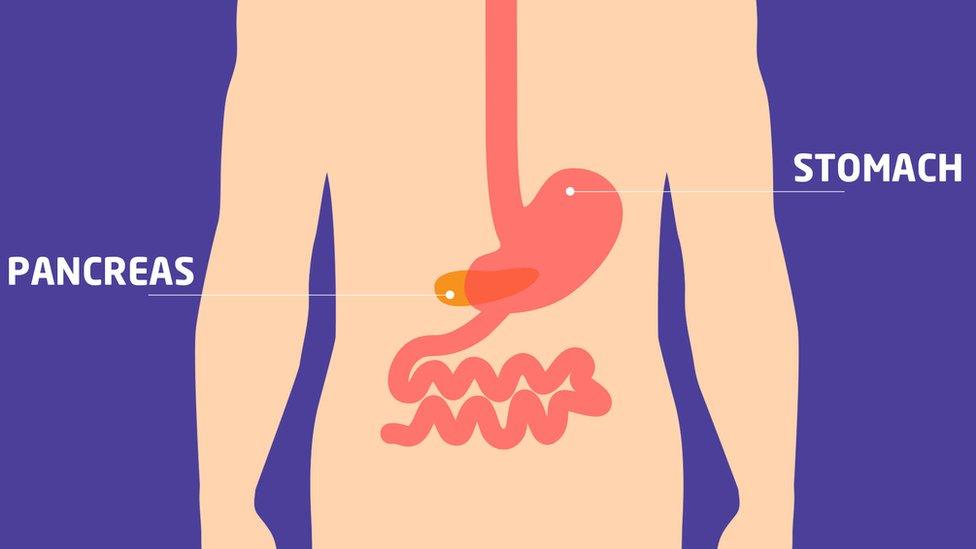Diabetes: NHS to offer 'artificial pancreas' to children with type 1 diabetes
- Published
- comments

Finger prick blood tests are one way for diabetics to monitor their blood sugar levels
More than 150,000 children and adults with type 1 diabetes will be able to access "life changing" technology on the NHS.
The National Institute of Health and Care Excellence (Nice) - which suggests which treatments should be available - has recommended that people in England and Wales can get a wearable device if their diabetes is not being properly controlled by their current pump or glucose monitor.
The device, which is sometimes called an artificial pancreas, has been shown to be better at keeping blood sugar levels within a healthy range, which is important for people with diabetes.
People with type 1 diabetes aren't able to control the amount of glucose - or sugar in their blood and if it's not monitored it can become quite dangerous.
What has been announced?

Insulin helps diabetics manage their blood sugar levels and is traditionally injected with a pen-like device such as this one
There are thought to be around 29,000 children in the UK who have type 1 diabetes.
Now, a new way of helping these people is being launched on the NHS in England and Wales.
Called a hybrid closed loop system - the wearable device mean people do not need to rely on other methods to control their blood sugar levels.
Nice said it has agreed with NHS England that children and young people will be among the first to be offered this device as part of a five-year roll-out plan.
Professor Jonathan Benger, chief medical officer at Nice, said: "Using hybrid closed loop systems will be a game changer for people with type 1 diabetes.
"By ensuring their blood glucose levels are within the recommended range, people are less likely to have complications."
How does the new technology work?

Insulin is a hormone that is produced by an organ called the pancreas, which is located just behind the stomach
The technology works via a continuous glucose monitor sensor which is attached to the body and transmits data to a body-worn insulin pump.
This pump then calculates how much insulin a person needs and delivers the exact amount to the body.
This kind of system mean that people with type 1 diabetes do not need to rely on finger prick blood tests or injecting insulin to control their blood sugar levels - which they otherwise would have done.
Dr Partha Kar, national specialty adviser for diabetes said: "This tech might sound sci-fi like but it will have a dramatic impact on the quality of people's lives," adding that it will mean "people with type 1 diabetes can get on with their lives without worrying about glucose levels or medication."
What is diabetes?
There are two types of diabetes - type 1 and type 2.
Type 1 diabetes. Type 1 diabetes causes the level of glucose - or sugar - in the blood to become too high.
It happens when an organ in the body called the pancreas cannot produce enough of a hormone called insulin, which controls blood glucose.
People with type 1 diabetes need to take insulin every day in order to keep their blood glucose levels under control.
They also have to monitor their blood sugar levels throughout the day.
Things such as playing sport and the food they eat can all affect the amount of insulin needed.
Type 2 diabetes. In type 2 diabetes the person's body cells no longer respond to insulin produced by the pancreas.
Type 2 diabetes is more common among adults, especially older people.
There is also a link between rising levels of obesity in the population and increasing levels of type 2 diabetes.
When someone is diagnosed with type 2 diabetes, they are usually told to make changes to their diet and do more exercise.
That's because type 2 is caused by a build up of so much glucose in the body that it can't cope.
Reducing the amount of fatty and sugary foods a person eats and exercising more can really help to control blood sugar levels in their body.
In some cases people with type 2 may also be given medicine or extra insulin too.
